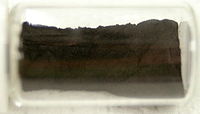
Photo from wikipedia
Abstract Barrier-free MgB2 wires with four different metallic sheaths, Nb, Fe, Ni and stainless steel, respectively, were fabricated by the internal magnesium diffusion into boron process. It was shown that… Click to show full abstract
Abstract Barrier-free MgB2 wires with four different metallic sheaths, Nb, Fe, Ni and stainless steel, respectively, were fabricated by the internal magnesium diffusion into boron process. It was shown that mechanical strength of metallic sheath affects the B powder density and consequently also the kinetics of MgB2 phase formation. While no interaction has been found at the MgB2/Nb interface after final heat treatment at 650 °C/30 min, reaction layers of 0.8–5.0 μm were created in wires with the other sheaths. Different shapes of the resistive transitions have been observed due to differences in the boron densification and consequent Mg diffusion kinetics, which affect the purity of the created MgB2 phase. Electrical measurements have shown the highest current densities for the mechanically softest Nb sheathed wire and the lowest ones for SS sheathed wire. This is attributed to worsened diffusion of magnesium into highly densified boron powder inside the mechanically strong metallic sheath. Thermal stability is related to the electrical and thermal conductivity of the metallic sheath, which is the worst for stainless steel and the best one for Nb.
Journal Title: Journal of Alloys and Compounds
Year Published: 2020
Link to full text (if available)
Share on Social Media: Sign Up to like & get
recommendations!